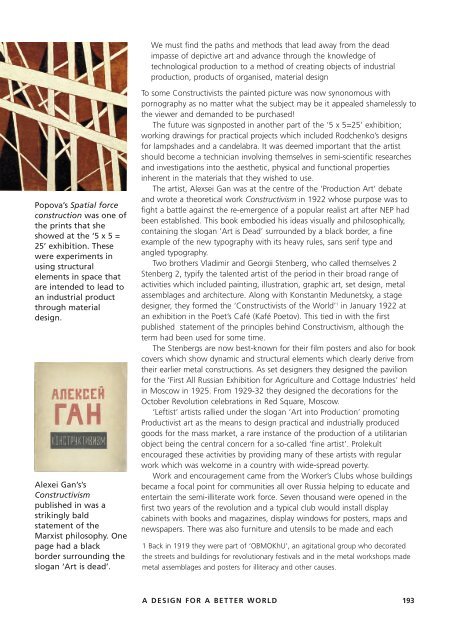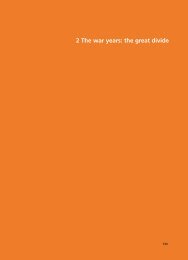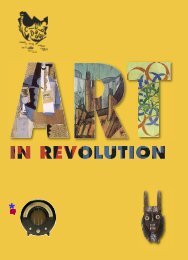Art in Revolution 3 - newleafdesign.me.uk
Art in Revolution 3 - newleafdesign.me.uk
Art in Revolution 3 - newleafdesign.me.uk
Create successful ePaper yourself
Turn your PDF publications into a flip-book with our unique Google optimized e-Paper software.
We must f<strong>in</strong>d the paths and <strong>me</strong>thods that lead away from the deadimpasse of depictive art and advance through the knowledge oftechnological production to a <strong>me</strong>thod of creat<strong>in</strong>g objects of <strong>in</strong>dustrialproduction, products of organised, material designPopova’s Spatial forceconstruction was one ofthe pr<strong>in</strong>ts that sheshowed at the ‘5 x 5 =25’ exhibition. Thesewere experi<strong>me</strong>nts <strong>in</strong>us<strong>in</strong>g structuralele<strong>me</strong>nts <strong>in</strong> space thatare <strong>in</strong>tended to lead toan <strong>in</strong>dustrial productthrough materialdesign.Alexei Gan’s’sConstructivismpublished <strong>in</strong> was astrik<strong>in</strong>gly baldstate<strong>me</strong>nt of theMarxist philosophy. Onepage had a blackborder surround<strong>in</strong>g theslogan ‘<strong>Art</strong> is dead’.To so<strong>me</strong> Constructivists the pa<strong>in</strong>ted picture was now synonomous withpornography as no matter what the subject may be it appealed sha<strong>me</strong>lessly tothe viewer and demanded to be purchased!The future was signposted <strong>in</strong> another part of the ‘5 x 5=25’ exhibition;work<strong>in</strong>g draw<strong>in</strong>gs for practical projects which <strong>in</strong>cluded Rodchenko’s designsfor lampshades and a candelabra. It was dee<strong>me</strong>d important that the artistshould beco<strong>me</strong> a technician <strong>in</strong>volv<strong>in</strong>g themselves <strong>in</strong> semi-scientific researchesand <strong>in</strong>vestigations <strong>in</strong>to the aesthetic, physical and functional properties<strong>in</strong>herent <strong>in</strong> the materials that they wished to use.The artist, Alexsei Gan was at the centre of the ‘Production <strong>Art</strong>’ debateand wrote a theoretical work Constructivism <strong>in</strong> 1922 whose purpose was tofight a battle aga<strong>in</strong>st the re-e<strong>me</strong>rgence of a popular realist art after NEP hadbeen established. This book embodied his ideas visually and philosophically,conta<strong>in</strong><strong>in</strong>g the slogan ‘<strong>Art</strong> is Dead’ surrounded by a black border, a f<strong>in</strong>eexample of the new typography with its heavy rules, sans serif type andangled typography.Two brothers Vladimir and Georgii Stenberg, who called themselves 2Stenberg 2, typify the talented artist of the period <strong>in</strong> their broad range ofactivities which <strong>in</strong>cluded pa<strong>in</strong>t<strong>in</strong>g, illustration, graphic art, set design, <strong>me</strong>talassemblages and architecture. Along with Konstant<strong>in</strong> Medunetsky, a stagedesigner, they for<strong>me</strong>d the ‘Constructivists of the World’ 1 <strong>in</strong> January 1922 atan exhibition <strong>in</strong> the Poet’s Café (Kafé Poetov). This tied <strong>in</strong> with the firstpublished state<strong>me</strong>nt of the pr<strong>in</strong>ciples beh<strong>in</strong>d Constructivism, although theterm had been used for so<strong>me</strong> ti<strong>me</strong>.The Stenbergs are now best-known for their film posters and also for bookcovers which show dynamic and structural ele<strong>me</strong>nts which clearly derive fromtheir earlier <strong>me</strong>tal constructions. As set designers they designed the pavilionfor the ‘First All Russian Exhibition for Agriculture and Cottage Industries’ held<strong>in</strong> Moscow <strong>in</strong> 1925. From 1929-32 they designed the decorations for theOctober <strong>Revolution</strong> celebrations <strong>in</strong> Red Square, Moscow.‘Leftist’ artists rallied under the slogan ‘<strong>Art</strong> <strong>in</strong>to Production’ promot<strong>in</strong>gProductivist art as the <strong>me</strong>ans to design practical and <strong>in</strong>dustrially producedgoods for the mass market, a rare <strong>in</strong>stance of the production of a utilitarianobject be<strong>in</strong>g the central concern for a so-called ‘f<strong>in</strong>e artist’. Prolekultencouraged these activities by provid<strong>in</strong>g many of these artists with regularwork which was welco<strong>me</strong> <strong>in</strong> a country with wide-spread poverty.Work and encourage<strong>me</strong>nt ca<strong>me</strong> from the Worker’s Clubs whose build<strong>in</strong>gsbeca<strong>me</strong> a focal po<strong>in</strong>t for communities all over Russia help<strong>in</strong>g to educate andenterta<strong>in</strong> the semi-illiterate work force. Seven thousand were opened <strong>in</strong> thefirst two years of the revolution and a typical club would <strong>in</strong>stall displaycab<strong>in</strong>ets with books and magaz<strong>in</strong>es, display w<strong>in</strong>dows for posters, maps andnewspapers. There was also furniture and utensils to be made and each1 Back <strong>in</strong> 1919 they were part of ‘OBMOKhU’, an agitational group who decoratedthe streets and build<strong>in</strong>gs for revolutionary festivals and <strong>in</strong> the <strong>me</strong>tal workshops made<strong>me</strong>tal assemblages and posters for illiteracy and other causes.A DESIGN FOR A BETTER WORLD 193





